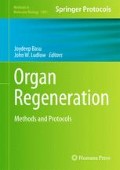Abstract
Here, we describe the use of a mouse model as a living bioreactor for the generation of tissue-engineered small intestine. Small intestine is harvested from donor mice with subsequent isolation of organoid units (a cluster of mesenchymal and epithelial cells). Some of these organoid units contain pluripotent stem cells with a preserved relationship with the mesenchymal stem cell niche. A preparation of organoid units is seeded onto a biodegradable scaffold and implanted intraperitoneally within the omentum of the host animal. The cells are nourished initially via imbibition until neovascularization occurs. This technique allows the growth of fully differentiated epithelium (composed of Paneth cells, goblet cells, enterocytes and enteroendocrine cells), muscle, nerve, and blood vessels of donor origin. Variations of this technique have been used to generate tissue-engineered stomach, large intestine, and esophagus. The variations include harvest technique, length of digestion, and harvest times.
Access this chapter
Tax calculation will be finalised at checkout
Purchases are for personal use only
References
Atala A (2009) Engineering organs. Curr Opin Biotechnol 20:575–592
Merrill JP, Harrison JH, Murray J et al (1956) Successful homotransplantation of the kidney in an identical twin. Trans Am Clin Climatol Assoc 67:166–173
Stollman N, Neustater B, Rogers A (1996) Short-bowel syndrome. Gastroenterologist 2:118–128
Lykins T, Stockwell J (1998) Comprehensive modified diet simplifies nutrition management of adults with short-bowel syndrome. J Am Diet Assoc 3:309–315
Peyret B, Collardeau S, Touzet S et al (2011) Prevalence of liver complications in children receiving long-term parenteral nutrition. Eur J Clin Nutr 65:743–749
Kato T, Tzakis A, Selvaggi G et al (2006) Intestinal and multivisceral transplantation in children. Ann Surg 243:764–766
Vacanti J, Morse M, Saltzman W et al (1988) Selective cell transplantation using bioabsorbable artificial polymers as matrices. J Pediatr Surg 23:3–9
Evans G, Flint N, Somers A et al (1992) The development of a method for the preparation of rat intestinal epithelial cell primary cultures. J Cell Sci 101:219–231
Sato T, Vries R, Snippert H et al (2009) Single Lgr5 stem cells build crypt-villus structures in vitro without a mesenchymal niche. Nature 459:262–265
Salerno-Goncalves R, Fasano A, Sztein M (2011) Engineering of a multicellular organotypic model of the human intestinal mucosa. Gastroenterology 141:18–21
Sala F, Matthews J, Speer A et al (2011) A multicellular approach forms a significant amount of tissue-engineered small intestine in the mouse. Tissue Eng 17:1841–1849
Grikscheit TC, Siddique A, Ochoa ER et al (2004) Tissue-engineered small intestine improves recovery after massive small bowel resection. Ann Surg 240:748–754
Sala FG, Kunisaki SM, Ochoa ER et al (2009) Tissue-engineered small intestine and stomach form from autologous tissue in a preclinical large animal model. J Surg Res 156:205–212
Agopian V, Chen D, Avansino J et al (2009) Intestinal stem cell organoid transplantation generates neomucosa in dogs. J Gastrointest Surg 13:971–982
Speer AL, Sala FG, Matthews JA et al (2011) Murine tissue-engineered stomach demonstrates epithelial differentiation. J Surg Res 156:205–212
Grikscheit TC, Ochoa ER, Ramsanahie A et al (2003) Tissue-engineered large intestine resembles native colon with appropriate in vitro physiology and architecture. Ann Surg 238:35–41
Acknowledgments
This work was supported by grants from the California Institute for Regenerative Medicine (#RN2-00946-1) (TG2-01168) and the Saban Research Institute
Author information
Authors and Affiliations
Editor information
Editors and Affiliations
Rights and permissions
Copyright information
© 2013 Springer Science+Business Media New York
About this protocol
Cite this protocol
Levin, D.E. et al. (2013). A “Living Bioreactor” for the Production of Tissue-Engineered Small Intestine. In: Basu, J., Ludlow, J. (eds) Organ Regeneration. Methods in Molecular Biology, vol 1001. Humana Press, Totowa, NJ. https://doi.org/10.1007/978-1-62703-363-3_25
Download citation
DOI: https://doi.org/10.1007/978-1-62703-363-3_25
Published:
Publisher Name: Humana Press, Totowa, NJ
Print ISBN: 978-1-62703-362-6
Online ISBN: 978-1-62703-363-3
eBook Packages: Springer Protocols

